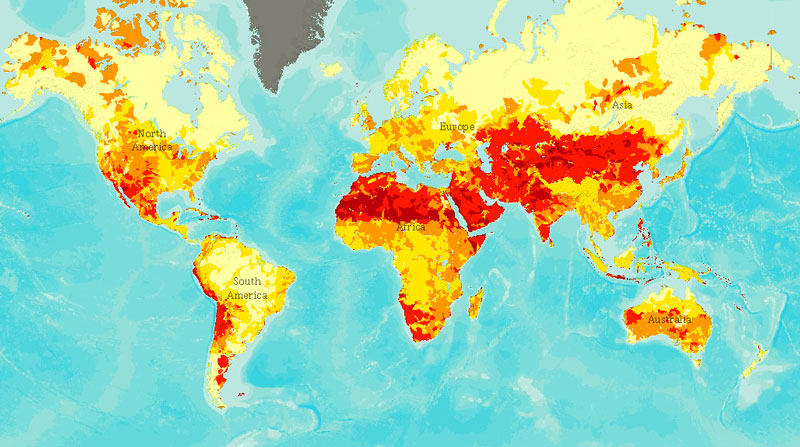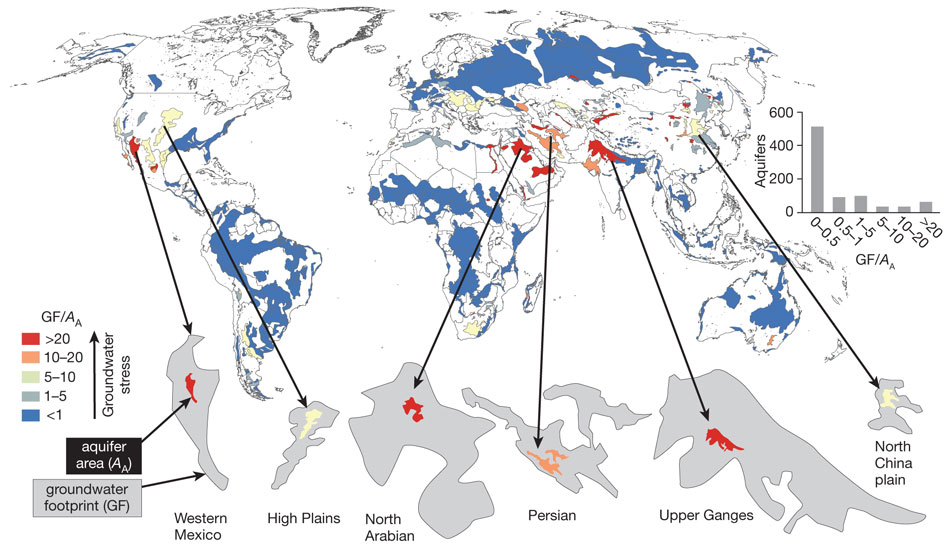-
World Water Day Focuses on Cooperation in the Face of Growing Stress
March 22, 2013 By Schuyler Null
Cooperation, not conflict; that’s the theme of this year’s World Water Day. Collaboration over water has been the rule rather than the exception over the past 70 years, UNESCO explained in the launch of their International Year for Water Cooperation initiative earlier this year (which the rest of the UN is thoughtfully supporting).
But the fact that there’s need for such an initiative shows that water conflict and other water issues are not far from the minds of global policymakers. Scarcity, drought, climate change, food security, disease – water impacts people and their governments in so many ways. Here’s a rundown of some of our best related posts.
Stress Visualized
Water security can be mapped via a number of indicators: groundwater depletion (in both renewable and non-renewable aquifers), rainfall, quality, and upstream water storage capacity, for example. The World Resources Institute’s Aqueduct Water Risk Atlas offers a composite index of a number of these indicators; a study in Nature shows the health and recharge rates of global aquifers; and a study in Environmental Research Letters maps Africa’s groundwater productivity.



A Transnational Issue
From transboundary river basins to maritime territorial disputes and drought-influenced food prices, water impacts state stability and international relations in myriad ways.
U.S. Intelligence Community’s Global Water Security Assessment: Produced at the behest of the U.S. Department of State with input from across the U.S. intelligence community, the National Intelligence Council’s assessment of global water threats, vulnerabilities, and fault lines provides a comprehensive outlook and calls for U.S. leadership.
Global Trends 2030: Increasing water scarcity is an important trend identified by the National Intelligence Council that will influence global affairs over the next two decades. “Many countries probably won’t have the wherewithal to avoid food and water shortages without massive help from outside,” writes principal author Mathew Burrows in their latest quadrennial report. And, combined with very young age structures in the Middle East, water shortages may increase the risk of intrastate conflict.
Nile Basin at a Turning Point: One of the world’s largest and most iconic shared river basins is at a crossroads: Egypt, Ethiopia, and South Sudan have new leadership; upstream countries are expanding and itching to develop hydropower; and existing treaties date back to the colonial era.
U.S. Drought, Global Food Prices, and Climate Change: Last summer’s record drought in the United States, combined with freak weather elsewhere in the world, led to soaring global food prices and fears that food riots and related instability could rock the world for the third time since 2007. Fortunately, though food prices remain relatively high, they crested and leveled off. Still, many fear that last year was a sign of things to come under increasingly more volatile global climate conditions.
Mapping East Asia’s Maritime Disputes: The Senkaku/Diaoyus. The Takeshima/Dokdos. The “Northern Territories.” The South China Sea. East Asia’s maritime territorial disputes can be dizzying; thankfully there’s this video.
China
Like so many other sectors, water in China deserves a discussion all its own. The Wilson Center’s China Environment Forum has partnered with Circle of Blue to produce Choke Point: China, a series of reporting trips to China and meetings in Washington, DC, that illuminate push forward discussion on the intersection of water and energy in the rapid development of the world’s most populous country.
Is beer the perfect illustration of the food-water-energy nexus? China’s Massive West-East Electricity Transfer Project: Mammoth infrastructure development is keeping China’s economic engine running at a fast clip. One of the largest is a nation-wide west to east electricity transfer project, bringing hydro power from the country’s water-rich inland and southern provinces to manufacturing centers on the coast.
Food Supply, Fracking, and Water Scarcity Challenge a Juggernaut Economy: “In effect, even as it grows bolder and wealthier, China also is producing extraordinary stress on its air quality, water supply, land, public health, as well as its long-term economic strength. But, unlike Las Vegas, we found that what happens in China with the soaring economic demand and deluge of wastes does not stay in China,” writes Circle of Blue’s Keith Schneider.
Health
Water is more than a security or infrastructure issue; at its core it’s a human health issue. Even in places where natural water resources are abundant, poor sanitation and pollution can lead to terrible impacts on local people, especially women, who often do the dirty and dangerous work of water collection and are especially vulnerable during pregnancy.
UNEP’s Africa Environment Outlook-3: The environment and human health are closely entwined, especially in places where people are directly reliant on natural resources for their livelihoods. The UN Environment Program recently found that a full 28 percent of Africa’s disease burden is a result of environmental factors like contaminated water, which causes diarrheal disease.
WASH and Biodiversity in Africa: Conservation advocates and the water, sanitation, and hygiene (WASH) community have a chance to combine their respective efforts and make more of a difference combined than alone, said David Bonnardeaux.
Fishing for Families in the Philippines: Communities in the Philippines are overwhelmingly dependent on the sea for sustenance. But population growth and overfishing has led to nearly every species of fish being at risk. Sam Eaton reports on a population, health, and environment initiative that incorporates sustainable fishing interventions with reproductive health and maritime conservation.
Women, Water, and Conflict: The walk from home to a water point can often be the most dangerous time of day for women in developing countries. And this violence has far reaching effects for women, children, and communities.
From Dirty Wells to Endocrine Disrupters at SEJ 2012: The impact of dirty water on women’s health is an important but neglected story, not only in developing countries like Nigeria, but also in the United States.
Sources: UN, UNESCO.
Photo Credit: Flooding in Pakistan, 2010, courtesy of NASA Goddard Photo and Video. Maps: World Resources Institute, Nature, and Environmental Research Letters. Video: SAB Miller.
Topics: Africa, agriculture, Asia, China, climate change, development, energy, environment, featured, global health, livelihoods, Middle East, natural resources, population, sanitation, security, U.S., UN, video, water
 A Publication of the Stimson Center.
A Publication of the Stimson Center.






